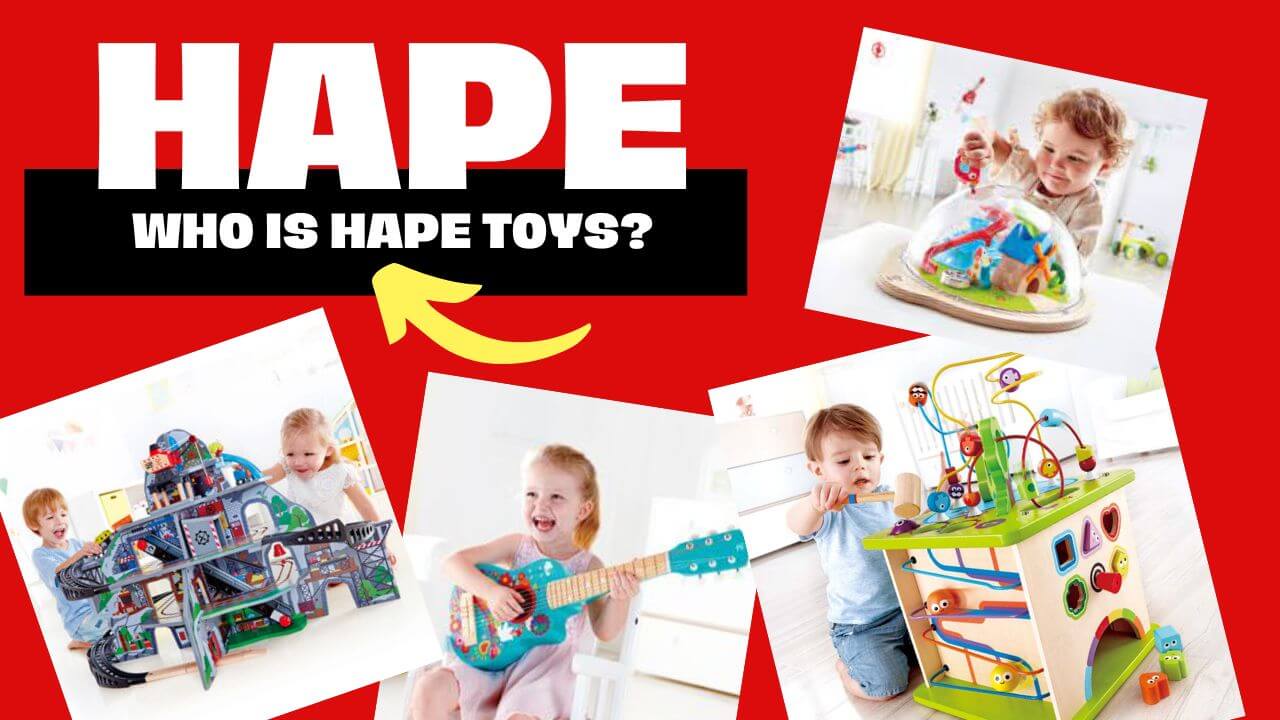You may be browsing for toys for your child and notice some brightly colored, beautiful, and well-made toys with the brand Hape. You wonder how to pronounce it, where Hape is from and why their toys are so well-loved by many. So who is Hape Toys?
Hape Toys is a German company founded by Peter Handstein in 1986. It isis a maker of educational toys for children. Hape's toys adhere to strict safety standards for children's toys from the US and Europe. Hape's toys also use plastic free from phthalates, lead, or BPA.
This post discusses Hape Toys, such as where they are from, how to pronounce the name, and if the toys are safe for children. We also will touch on where Hape toys are made.
Just a quick note that we're a Hape Flagship, so be sure to check out our massive selection of Hape toys!
About Hape Toys?
The name Hape may seem Scandinavian, sort of like LEGO. But it can also be English, so Hape can easily be an American or Australian company.
Hape is a German educational toy maker, established by Peter Handstein in 1986. Hape makes toys from high-quality and sustainable materials such as wood, bamboo, and recyclable plastics. Hape's toys suit children from many age range and are safe for children, adhering to many safety standards in the US and Europe.
Hape started as Hape Kindergarten Supply in 1986, focusing on procuring and supplying kindergarten with toys and necessities. It then launched into toys full-on and started expanding outside of Germany.
Its first international presence was in Switzerland, followed by China, Canada, Hong Kong, Italy, and many more. Aside from these countries, Hape also has offices in Japan, the UK, Portugal, Spain, and the Benelux.
Hape began producing toys in China in 1995, with the opening of their Ningbo plant. It designs toys in many of its international offices but manufactures them in China.
Hape also owns many major toy brands as well under its wings. Hape either launches its own sub-brands or acquires these brands outright. These brands include Kâthe Kruse, PolyM, Baby Einstein, Senger, and Eureka Kids.
How Do You Pronounce Hape Toys?
In many ways, the name 'Hape' can be rather confusing to pronounce, as we are not even sure the language it is spelled in. How do you pronounce Hape Toys?
Hape is pronounced as 'hah-pay.' It is pronounced as a German word, as the brand is from Germany. The word is an acrostic, combining the first syllable of its founder's surname, 'Hanstein,' and the second syllable from the first name, 'Peter.' The word also sounds like the word 'happy' in English.
To properly pronounce a word, it may be a good idea to start by discovering its language. This is because the Latin-based alphabet is used to write a wide variety of languages, from English to Italian, Spanish, and even Indonesian.
In Hape's case, since the company is from Germany, we can assume that the name is intended to be pronounced in German.
One good thing about the German language is its straightforwardness in pronunciation. German is always pronounced the way it is spelled. This makes it easier to pronounce, unlike English, which has many odd pronunciation rules such as 'silent' H (e.g., Honest, Hour.)
If you are to pronounce Hape in German, you pronounce it as 'hah-pay'.
The website also provided some explanation on the meaning of the word, which is actually an acrostic. The first syllable, 'Ha, ' refers to the surname of its founder, Peter Hanstein.
The second syllable, 'Pe,' is taken from his first name, 'Peter.' It is to be noted here that in German, the name Peter is pronounced 'pay-ter.'
Aside from reflecting the founder's name, the word Hape is also selected as it may sound like the English word 'Happy.' Perhaps this explains why the company uses 'Hape' instead of 'Peha.'
Are Hape Toys Made In Germany?
With globalization, many companies no longer manufacture in their own country. Instead, they move to countries with lower production costs, such as China or Vietnam, to lower their cost. Is Hape doing the same? Are Hape's toys made in Germany?
Hape's toys are manufactured in Ningbo, China. However, the design of its toys remains mainly in Germany. However, Hape owns these factories and monitors the materials used and the production procedure. Hape also ensures high standards to ensure compliance with European and US safety standards.
Hape toys are not made in Germany but in Ningbo, China. This makes Hape different from Bruder, another German toy company. Bruder kept their production in Germany. However, Hape did not simply outsource its production to China.
Some companies have a system of designing the product, contracting a factory in China to manufacture the goods. Then they take delivery and sell it. This method is commonly called third-party manufacturing.
One of the biggest issues with third-party manufacturing is quality assurance. It may be hard to enforce high-quality standards when you do not own, operate and maintain the factory.
Instead, Hape opened the factory in Ningbo and owned it. This means Hape produces its toys directly in China. With this structure, Hape can control the quality, procedures, and materials as desired.
As a result, Hape toys are well-made and adhere to many quality and safety standards for children's toys in Europe and the United States.
Is Hape Safe For Children?
Many people, upon hearing that Hape toys are made in China, immediately raise their concerns about the quality and safety of Hape's toys. Is Hape safe for children?
Hape Toys are safe for children. This is because despite their toys being made in China, Hape's toys comply with many standards for toys in the United States and Europe. These standards include EN71, ISO8124, AZO, ASTM F963, IETP, and many more.
Hape likely understands that people may be concerned about the safety standards of their toys since they manufacture in China. Perhaps this is why they are quite transparent about the safety standards they comply with.
EN71: Stands for European Standards For Toy Safety. All of the toys sold in the European Union are required to comply with this standard. It covers areas such as flammability, paints, use of compounds, mechanical properties of toys, and more.
ISO 8214: Stands for International Toy Safety Standards. This standard is based on EN71, with some additions such as age determination guidelines, phthalate regulation, and more.
AZO: Stands for EU AZO Colorants Directive 2002/61/EC. It essentially is a directive that no products sold in the EU should have AZO-based dyes. These dyes are known to pose health dangers.
ASTM F963: Stands for American Standard Consumer Safety Specification on Toy Safety. It regulates many things about toys, from the use of materials, chemicals allowed on the toy and paints, accessible edges and pints, and instructions.
IETP: Stands for International Ethical Toy Program. IETP aims to protect, support, and help improve the ethical and sustainability standards of the supply chain for toys worldwide.
GB 6675: Stands for Chinese Toy Safety Standard Updates. It covers aspects quite similar to EN71 and also ASTM F963.
SOR-2011-17: Stands for Canadian Safety Requirements for Children's Toys. Some unique areas it covers include decibel limits in toy sounds, materials used in stuffings and surface coatings, and phthalate content in plastics.
FSC: Stands for Forest Stewardship Council. It aims to promote sustainable forestry practice by producing standards and guidelines to help corporations source and determine sustainable forestry products.
BPA: Stands for (migration) requirement in Appendix C to Annex II to Commission Directive 2014/81/EU. The BPA is essentially a directive on using materials that may be carcinogenic (cancer-causing), mutational (may cause mutation), or toxic.
By adhering to this long list of standards, you can safely assume Hape Toys to be safe, sustainable, and manufactured to the highest quality standards available for toys worldwide.
Hape Toys Suit Children Of What Age?
One of the biggest headaches about buying toys is determining the age range. The last thing you want is to purchase toys that are too childish or challenging for a child.
Hape Toys are designed to be enjoyed by babies as young as 0+ months to 5+ years old. Toys for younger children tend to be simpler and smaller. Hape likely did not place a rigid age limit since babies and children develop and learn differently and may play with toys above their age range.
Hape did not specifically mention the age range of their toys, but we may be able to draw some clues from their website.
When looking at their online store, you may be able to categorize the toys by age range. The youngest age range is 0+ months, while the older age range is 5+ years old. From here, you can roughly estimate the suitable age range to enjoy Hape toys is 0 to 5+ years old.
However, you may also note that babies and children develop their cognitive and physical abilities at different speeds. What may be suitable for a 4-year-old may be boring to a very smart 3-year old for example.
Perhaps the best way to shop for toys is to bring their child to the toy store and let the child choose. Another way is to follow the age range recommendations printed on the toy's packaging as a guide.

